Nof S.Y. Springer Handbook of Automation
Подождите немного. Документ загружается.


545
Product Auto
32. Product Automation
Friedrich Pinnekamp
The combined effects of rapidly growing computa-
tional power, and the shrinking of the associated
hardware in recent decades, mean that almost
all products used in industry have acquired some
form of intelligence, and can perform at least part
of their functions automatically.
The influence of this development on global
society is breathtaking. Today, only 50 years after
the first indication of automation, the life of
individuals and the way industries work has been
transformed fundamentally.
The automation of a product requires the ability
to achieve unsupervised interaction between
the device’s various sensors and actuators, and
ultimately the ability to communicate and interact
with other units.
This chapter gives an overview of the require-
ments to be fulfilled in the automation of products,
and gives a flavor of today’s state of the art by
presenting typical examples of automated prod-
ucts from a wide range of industrial applications.
These examples cover automation in instrumenta-
tion, motors, circuit breakers, drives, robots, and
embedded systems.
32.1 Historical Background ........................... 545
32.2 Definition of Product Automation .......... 546
32.3 The Functions of Product Automation..... 546
32.4 Sensors................................................ 547
32.5 Control Systems .................................... 547
32.6 Actuators ............................................. 548
32.7 Energy Supply ...................................... 548
32.8 Information Exchange
with Other Systems............................... 548
32.9 Elements for Product Automation .......... 548
32.9.1 Sensors and Instrumentation......... 548
32.9.2 Circuit Breakers............................ 550
32.9.3 Motors ........................................ 551
32.9.4Drives ......................................... 552
32.9.5 Robots ........................................ 553
32.10 Embedded Systems ............................... 554
32.11 Summary and Emerging Trends ............. 557
References .................................................. 558
32.1 Historical Background
Some 50years ago the term product automation was
not even known. The door opener to the automation of
individual devices, components or products was a tiny
electronic circuit, commercially introduced by Fairchild
Semiconductors and Texas Instruments in 1961: the mi-
croprocessor.
Already 5 years later the trend towards progressive
miniaturization, known as Moore’s law, was initiated
and is still ongoing.
In the 1970s the development of the microproces-
sors geared up and led to the RISC (reduced instruction
set computer) processors and very-large-scale integra-
tion (VLSI) in the 1980s. In the 1980s the step from 32
to 64bit processors was taken.
In 1992, DEC introduced the Alpha 21064 at
a speed of 200MHz. The superscalar, superpipelined
64bit processor design was pure RISC, but it outper-
formed the other chips and was referred to by DEC as
the world’s fastest processor.
Today in 2007 the flagships of microprocessors are
built in 65nm technology, have about 170 million tran-
sistors, and tact frequencies of 2000MHz.
Part D 32

546 Part D Automation Design: Theory and Methods for Integration
With such a powerful brain embedded in a device,
automation has almost unlimited potential.
The enormous impact of this revolutionary tech-
nical development on society is obvious. It changed
the daily life of almost all people in the world.
The personal computer (PC) is based on micropro-
cessors, transforming the way of working in offices
and factories fundamentally. Microprocessors crept
into almost all devices and made the use of ma-
chines much more convenient (at least after all the
manuals themselves have developed into embedded
systems).
Production of goods boosted to new productivity
levels with microprocessors and there is hardly a sin-
gle niche in our life that is not covered by automation
devices today.
32.2 Definition of Product Automation
Product automation is a notation that can easily be
confused with production automation or automation
products,allnamesusedinindustry.Toaddtothe
confusion, the individual terms product and automa-
tion have a wide range of meanings themselves. Before
we discuss product automation itseemstobeap-
propriate to clearly describe what we understand by
this.
Production automation is the automation of indi-
vidual steps or the whole chain of steps necessary to
produce. The otherwise manual part of the manufac-
turing is therefore carried out or supported by tools,
machines or other devices.
Industries that produce such tools or machines call
their devices products. Products used to automate pro-
duction can be called automation products. Examples
are numerical controlledmachines, robots or sorting de-
vices. These automation products serve individual steps
or support the infrastructure ofan automated production
line.
To be able to do this, these products or devices
must possessa certaindegree of automation themselves.
A motor that drives the arm of a robot, for example,
must be able to receive signals for its operation and
must have some mechanism to start its operation on re-
quest. Thus a motor, to use this example, must itself be
automated.
When we talk about product automation we have
in mind the automation of devices that fulfill various
tasks in industry, not necessarily only tasks in produc-
tion processes. A device with automation capabilities
can also be used as a stand-alone unit to serve individual
functions.
Thus product automation is the attempt to equip
products with functionality so that they can fulfill their
tasks fully or partly in an automated way.
In this chapter we want to describe the state of the
art and the trends in automating products.
The functions required to transform a simple tool,
say a hammer, into an automated product – in this case
it may be a robot executing the same movement with
the hammer as we would do with our arm – are very
different, both in nature and complexity.
From the large variety of combinations of these
functions we select a dozen typical applications or
product examples to give a feeling of the status of im-
plementation of automation on the product level.
Further examples can be found in [32.1]
32.3 The Functions of Product Automation
The hammer mentioned above is a good example of
a whole class of products (or devices) with the task of
providing a mechanical impulse to another object (in
most cases a nail). This hammer is useless if no one is
taking it and using it as a tool.
To make a simple hammer an automated hammer,
we need an additional system that provides at least the
functions a person would apply to the hammer in order
to make it useful.
We have to give the hammer a target (hit that spe-
cific nail), we need a force (an actuator) to move the
hammer, and we have to control the movement in var-
ious aspects: acceleration, direction, speed, angle of
impact, precision of the path. We have to inform the
Part D 32.3
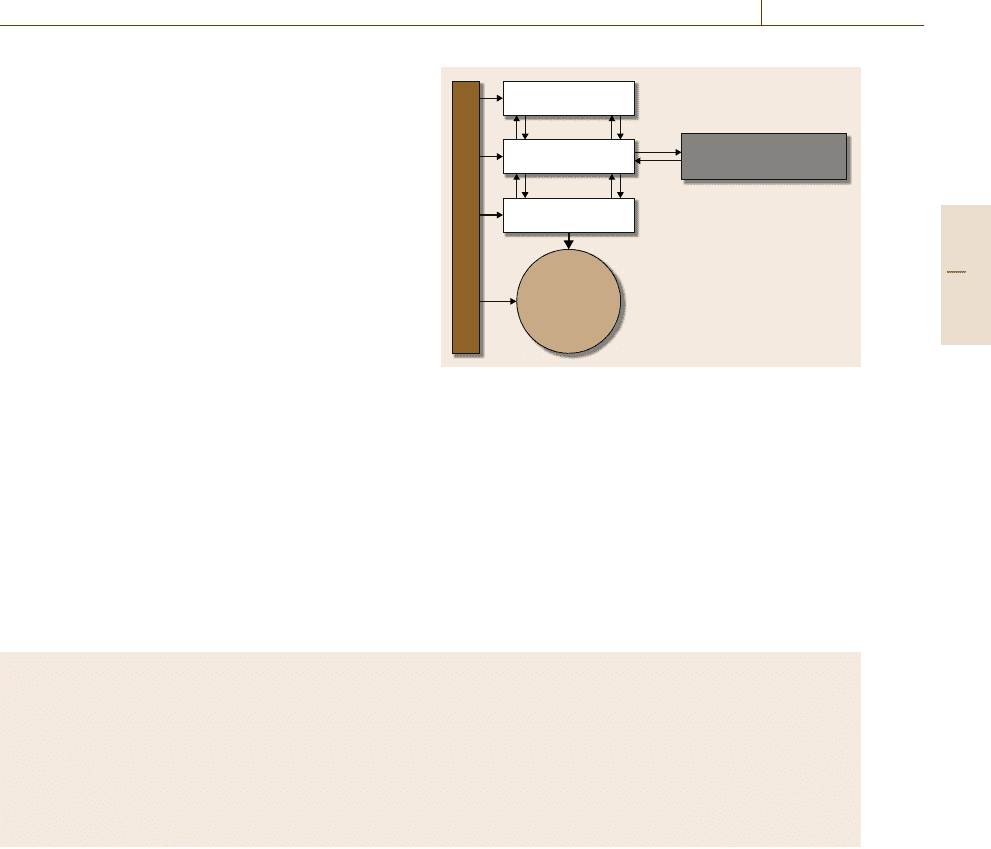
Product Automation 32.5 Control Systems 547
Fig. 32.1 The functional blocks required for automating
adevice
control system (the brain) that the task is executed and
we have to put the hammer back into a default position
after the hit. In addition, we need an energy source to
provide the power for the operation and we need some
sensors (eyes, ears,fingers) to inform the controlsystem
about the status of the hammer and its position during
the action.
In a more schematic way the requirements for au-
tomation look like the following.
Primary task
of the device
Sensors
Control system
Information exchange
with other systems
Actuators
Energy
32.4 Sensors
To automate a device, sensors are required to inspect the
environment and provide information about the subse-
quent reaction of the device.
It depends very much on the task to be car-
ried out with the product which type of sensor is
Table 32.1 Physical parameters to be measured by a sensor
Mechanical properties Distance, speed, acceleration, position, angle, mass flow, level, tension,
movement, vibration
Thermodynamic properties Temperature, pressure, composition, density, energy content
Electrical properties Voltage, current, phase, frequency, phase angle, conductivity
Magnetic properties Magnetic field
Electromagnetic properties Radiation intensity, light fluctuations, parameters of light propagation
Other properties Radioactivity
adequate (see Chap. 20 in this handbook and [32.2,
3]).
Table 32.1 gives an overview on the physical pa-
rameters to be measured by the sensor when specific
properties are applicable.
32.5 Control Systems
The signals from the sensors, in either analog or digital
form, have to be interpreted and compared with a model
of the device task in order to initiate the actuators. The
control system therefore contains all algorithms to pro-
vide a proper operation of the device.
Simple logical controllers are used for on–off func-
tions. Sequence controllers are used for time-dependent
operations of the devices (Chap. 9 on control theory
and [32.4–6]).
Proportional–integral–derivative (PID) controllers
are widely used for parameter control, and the even
more sophisticated model-basedcontrol systemssee use
in device control. For example, the starter of a motor to
close a valve may need to adjust its current ramp-up
curve according to the behavior of the overall sys-
tem in which this valve and its automated motor are
embedded.
Part D 32.5

548 Part D Automation Design: Theory and Methods for Integration
32.6 Actuators
Actuators are the devices through which a controller
acts on the system. As in the case of sensors, the spe-
cific type of the actuator depends very much on the
application [32.7,8].
Mechanical movements are introduced by spring
mechanisms, hydraulic and/or pneumatic devices, mag-
netic forces, valves or thermal energy. Changes of
thermodynamic properties are introduced through heat-
ing or cooling or pressure variations, for example.
Electrical properties are modified by charging or
dischargingcapacitors orapplication ofvoltageand cur-
rent, just to mention a few.
32.7 Energy Supply
Energy is required to perform the primary function of
the device. It can be supplied in various forms such as
mechanical, electrical or thermal.
Energy is also required to operate the sensors, actu-
ators, and control systems as well as the communication
channels within or to the outside of the device.
Energy (in most cases electrical energy) can be sup-
plied from remote sources, either via cables or without
a wired connection (for example, transmitted through
electromagnetic fields), or taken from device internal
storage systems, mostly batteries (in rare cases also fuel
cells).
In the long term, the energy supply for systems that
must operate in remote locations for long periods with-
out intervention will develop into a design issue – for
example, through suitable storage mechanisms.
32.8 Information Exchange with Other Systems
To operate in an automatic way, a device often has to
communicate with its environment. For stand-alone de-
vices, this information exchange is provided through
sensors that observe the external parameters. In the ma-
jority of cases, however, the automated device must
communicate with peer devices or with a superordinate
control system.
Basic information for the function of the device has
to be transferred and, if necessary, updated. Such up-
dates can affect anything from operating data to the
master program for the operation.
It may be necessary for an operator to communi-
cate with the device, thus a man–machine interface is
required.
Other devices or higher control systems may require
information exchange in both directions, to activate the
device, get a status report or synchronize with other
devices in a larger system.
A language for the communication has to be defined
and here several standards have been developedover the
years as automation was spreading across industry.
32.9 Elements for Product Automation
The overview above covers the broad spectrum of as-
pects and applications in product automation. In the
following, some prominent examples of state-of-the-art
implementation of the related technologies are given.
32.9.1 Sensors and Instrumentation
Instrumentation is a crucial element in product automa-
tion. The information required to effectively automate
a product has to be gathered in an adequate way. The
state of the art in sensor technology shall be demon-
strated with a few examples only, characterizing the
level of technology required in modern sensors.
Figure 32.1 shows both a pressure and a tem-
perature sensor. In both cases the probe itself is the
crucial but is by far a minor part of the whole system.
Most of the technology is located in the electronic part
that serves as data evaluation and signal transmission.
Part D 32.9
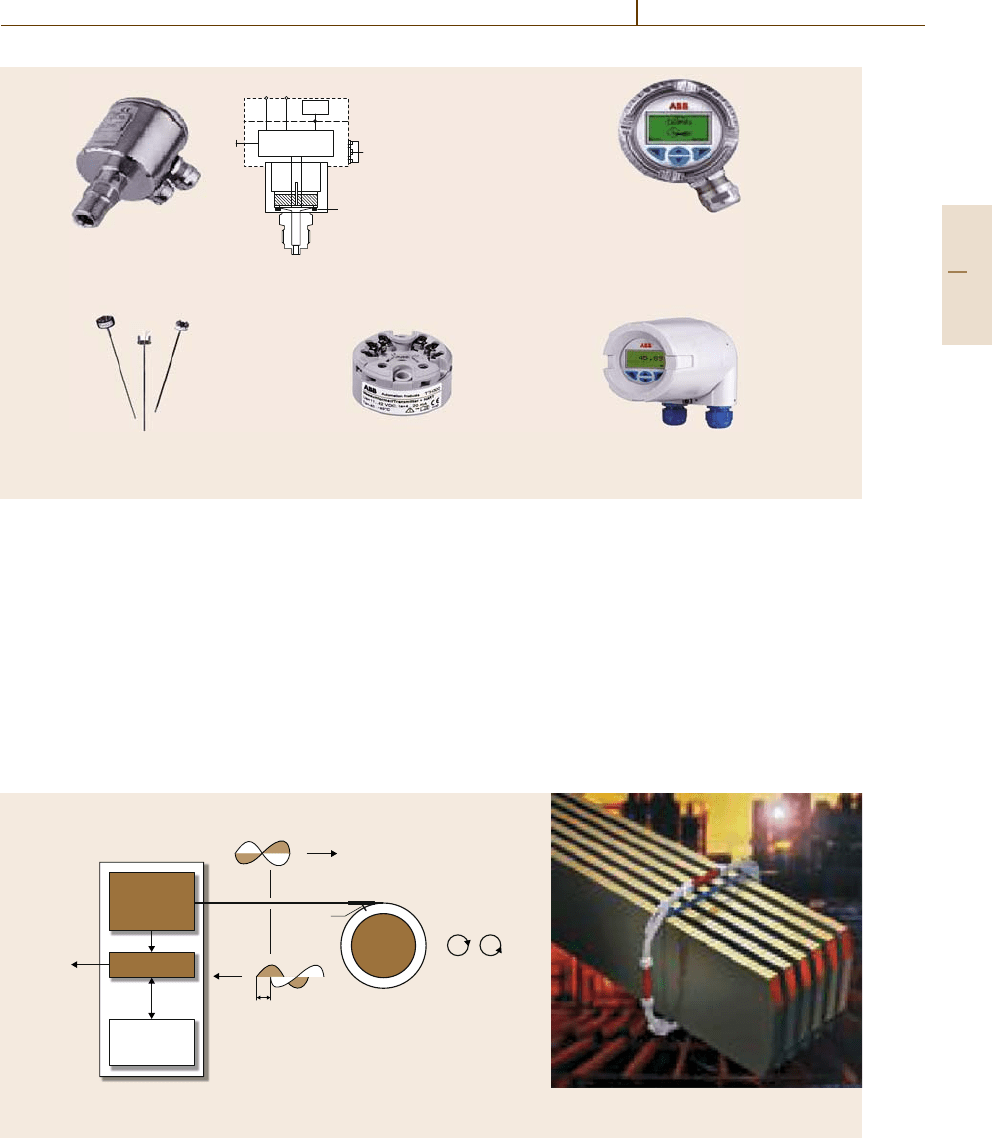
Product Automation 32.9 Elements for Product Automation 549
a
bc
d
e
Pressure transmitter for
absolute pressure
a Output and auxiliary power
supply
b Zero/span adjustment
c Microprocessor-supported
electronics
d Measuring mechanism
e O-ring
Pressure transmitter 261
from the 2600T series of
ABB
The high-performance TTF300
temperature transmitter of ABB
Temperature transmitters
TTH300 of ABB with HART
communication
Temperature probes
Fig. 32.1 Examples of pressure and temperature sensors (after [32.9,10])
Signal transmission takes place via a communication
protocol.
A further critical element is the human–machine in-
terface, which is becoming more intuitive in its use. The
user is provided only a few simple buttons to check or
modify the settings of the sensors.
A high degree of automation is put into the
peripheral aspects of the sensors after the primary mea-
surement system of the physical parameters have been
developed to perfection.
Orthogonal linear
light waves
Schematic illustration of ABB's fiber-optic sensor
for high DC currents
Sensor head housing mounted around
current carrying bus bars
Profibus
4–20 mA
0–1 V
Opto-
electronics
module
Interface
AC 800 PEC
controller
Power
link
Δφ
Left and right
circular light
waves
Retarder
Current
conductor
Sensing
fiber cell
Reflector
Fiber
y
x
Fig. 32.3 Fiber-optic current sensor (after [32.11])
Other sensors are built on new sensing technol-
ogy, perfecting physical effects such as the influence of
a magnetic field on the polarization of light waves prop-
agating in this field. Figure 32.3 shows such a sensor for
measuring the direct-current (DC) in a foundry.
The sensor as such consists of an optical fiber
wound around the current-carrying bar. The magnetic
field generated by the current influences the light prop-
agation in the fiber, from which the amplitude of the
current can be derived.
Part D 32.9

550 Part D Automation Design: Theory and Methods for Integration
Arrangement of the displacement body in
a paramagnetic oxygen sensor
Planar micro-electromechanical system (MEMS)
sensor chip (inner volume approximately 100 mm
3
)
Copensation
coil
Magnetic field
concentrator
Magnetic field
concentrator
Displacement
body
Mirror
S
Light source
Photodetectors
Fig. 32.4 Micro-electromechanical oxygen sensor (after [32.12])
The electronic processing of the transformed light
signal occupies the central part of the sensor.
Making use of micro-electromechanical systems
(MEMS) technology, the sensors themselves become
more accurate and easier to manufacture [32.13,14].
An example of this development towards silicon-
based systems is the oxygen sensor head shown in
Fig.32.4.
Compared with other gases, oxygen shows a high
magnetic susceptibility, and this is used to detect it in
a gas flow. The sensor consists of a displacement body
located in a strong magnetic field gradient. The torque
of this body is a measure of the concentration of the
magnetic oxygen gas. With silicon manufacturing tech-
nology these delicate mechanical devices can be cut
out on chips and integrated into the overall measuring
system.
Fig. 32.5 Automated circuit breakers for different power levels
32.9.2 Circuit Breakers
Circuit breakers are devices that connect or discon-
nect electrical energy to a user and, in addition,
interrupt a short-circuit current in case of emergency
(Fig.32.5) [32.15].
While the primary mechanism for this function is
the mechanical movement of metal contacts, modern
versions of this product show a very high degree of
automation.
State-of-the-art circuit breakers therefore have
a quick and user-friendly way of setting trip parameters
– preferably a method that can be instantiated offline
and before installation of the circuit breaker. In addi-
tion, they offer a complete indication of why a trip
occurs, and a data-logger function to record all electri-
cal quantities surrounding the tripping event. Accessing
Part D 32.9

Product Automation 32.9 Elements for Product Automation 551
this information quickly and from anywhere, without
the need to plug a direct physical connections between
the trip unit and the PC or personal digital assistant
(PDA) are also features of modern products.
An important element in any circuit breaker is a cur-
rent sensor. In low-voltage circuit breakers, which are
fitted with electronic trip units, these sensors are not
only used for current measurement, but they must also
provide sufficient energy to power the electronics.
A commonly used sensor is a Rogowsky coil that
provides a signal proportional to the derivative of the
current – this signal needs to be integrated. This is done
digitally with a powerful digital signal processor (DSP),
which is part of the overall multiprocessor architecture,
and essentially theheart ofthe tripunit. Infact, this DSP
is used to carry out other functions, for example, com-
munications, that in previous designs required separate
hardware components.
The elimination of these hardware components
combined with a simplified trip unit input stage means
that a single printed circuit board (PCB) is all that is
required for the unit’s electronics. This is a vast im-
provement on previous designs where four PCBs were
needed to provide the same functionality.
The circuit breaker shown in Fig.32.6 also has
an integrated human–machine interface (HMI) [32.15].
A high-definition, low-power-consuming graphical dis-
play makes data easier to read. And, because of an
energy-storing capacitor, a descriptionof the alarms can
be displayed for up to 48 h without the need for an
auxiliary power supply. Nevertheless, these alarm de-
scriptions are saved and can be viewed long after this
48h periodhas elapsedby simplypoweringthe tripunit.
A wireless link, based on Bluetooth technology,
connects the trip unit to a portable PC, PDA or laptop.
This enables users to operate in a desktop environment
familiar to them. From this environment operators can
Fig. 32.6 HMI of a circuit breaker
use electric network dimensioning support programs to
ensure optimal adjustment of the protection functions.
In addition, users can print reports, save data on differ-
ent media, or send data by e-Mail to other parties from
the comfort of their own desk.
The use of fieldbus plug devices allows a choice of
fieldbus (e.g., DeviceNet or Profibus DP) that best suits
the user’s specific needs when connecting the circuit
breakers to an overall system.
32.9.3 Motors
Motors are the most common devices in produc-
tion automation, being part of production lines or
of robots [32.16]. The need to automate the motors
themselves is therefore very high, but also motors in
stand-alone application have automation features built
in for various reasons.
To avoid negative influence on the electrical supply
system when motors are switched on, the most common
automation device is the soft starter: when a certain
motor power output is required, the optimal solution
(depending on the power network conditions and re-
quirements) becomes a frequency converter start, also
called a soft start. This allows the motor to be started
at high torque without causing any voltage drop on the
power network.
The converter brings the motor up to speed. Upon
reaching nominal speed and after being synchronized to
the network, the circuit breaker between the converter
and the power network is opened. The breaker between
the motor and the network is then closed. Finally, the
breaker between the motor and the converter is opened.
The control systems to manage the motor come in
two basic varieties. Closed-loop control systems have
encoders in the motor to report its status. This is used as
feedback information for the control algorithm. Open-
loop systems are simpler because these encoders are
omitted, but at the price of a lower control accuracy.
With model-based control, however, the accuracy of
a closed-loop is achieved without encoders. ABB’s di-
rect torque control technology is an example for this
modern approach: it uses mathematical functions to
predict the motor status. The accuracy and repeatabil-
ity delivered is comparable to closed-loop systems, but
with the added bonus of a higher responsiveness (up to
ten times as fast).
Direct torque control (DTC) is a control method
that gives electronic variable-speed motor controllers
[alternating-current (AC) drives] an excellent torque
response time. For AC induction machines, it deliv-
Part D 32.9
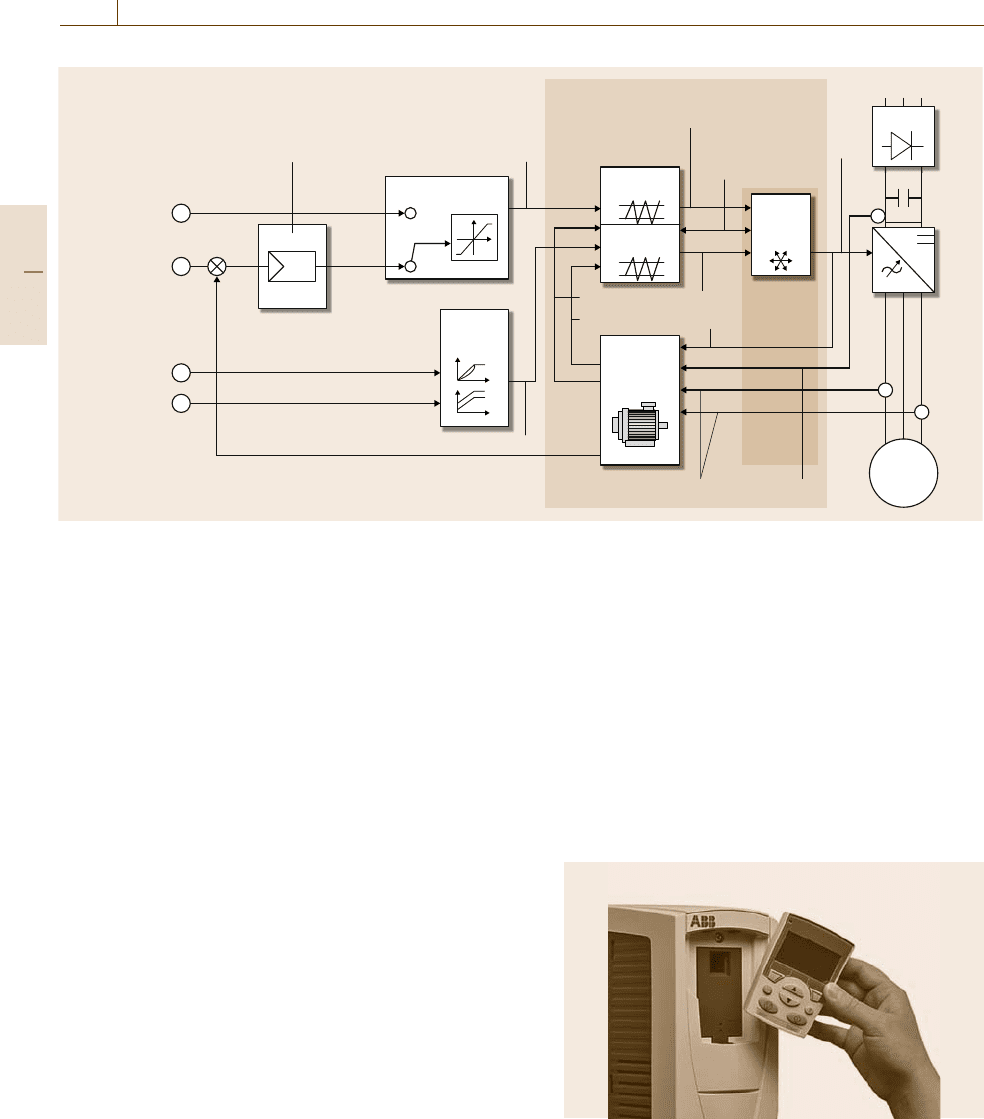
552 Part D Automation Design: Theory and Methods for Integration
Torque reference
controller
Internal torque
reference
Internal flux reference
Torque
comparator
Adaptive
motor
model
Optimum
pulse
selector
ASIC
M
3 ~
Torque status
Flux status
Motor current DC bus voltage
Actual torque
DC bus
Inverter
Switch positions
Switch position
commands
Mains
Rectifier
Actual flux
Control signals
Flux
comparator
Flux
reference
controller
U
t
U
t
Torque reference
Speed reference
Actual speed
Flux optimizing
on/off
Flux braking
on/off
Speed controller
+ acceleration compensator
P
ID
+
–
DTC core
Fig. 32.7 Block diagram of DTC (after [32.17])
ers levels of performance and responsiveness reaching
the machine’s theoretical limits in terms of torque and
speed control (Fig.32.7).
DTC uses a control algorithm that is implemented
on a microcontroller embedded in the drive. The tech-
nology was first used commerciallyin 1995, and rapidly
became the preferred control scheme for AC drives, es-
pecially for demanding or critical applications, where
the quality of the control system could not be compro-
mised.
32.9.4 Drives
In the above example of motor automation, soft starters
for smaller motors are often integrated into the motor
itself.
The control systems to manage larger motors
become large in themselves – like their smaller coun-
terparts, they are equipped with power electronic
components as well as control processors and periph-
eral systems, but the size of these rises with their power
capability.
Such units are called drives. Today drive units can
power motors of up to 50MW. The continuing decrease
in size and increase in power in such units is driven by
improvements in power electronics and microelectron-
ics.
When welook ata drive device as a productin itself,
the automation of this product is mainly by two grow-
ing requirements: a simplified man–machine interface
and communication issues within a system of which the
drive is part.
Intelligent drives are certain to benefit from the
growth of Ethernet communications by becoming an
integral part of control, maintenance, and monitoring
systems. Decentralized control systems will be created
in which multiple drives share control functions, with
one taking over in the event of a fault or error in another
drive. The advantage of this is that reliance on costly
Fig. 32.8 Assistant control panels allow easy program-
ming of standard drives (after [32.18])
Part D 32.9
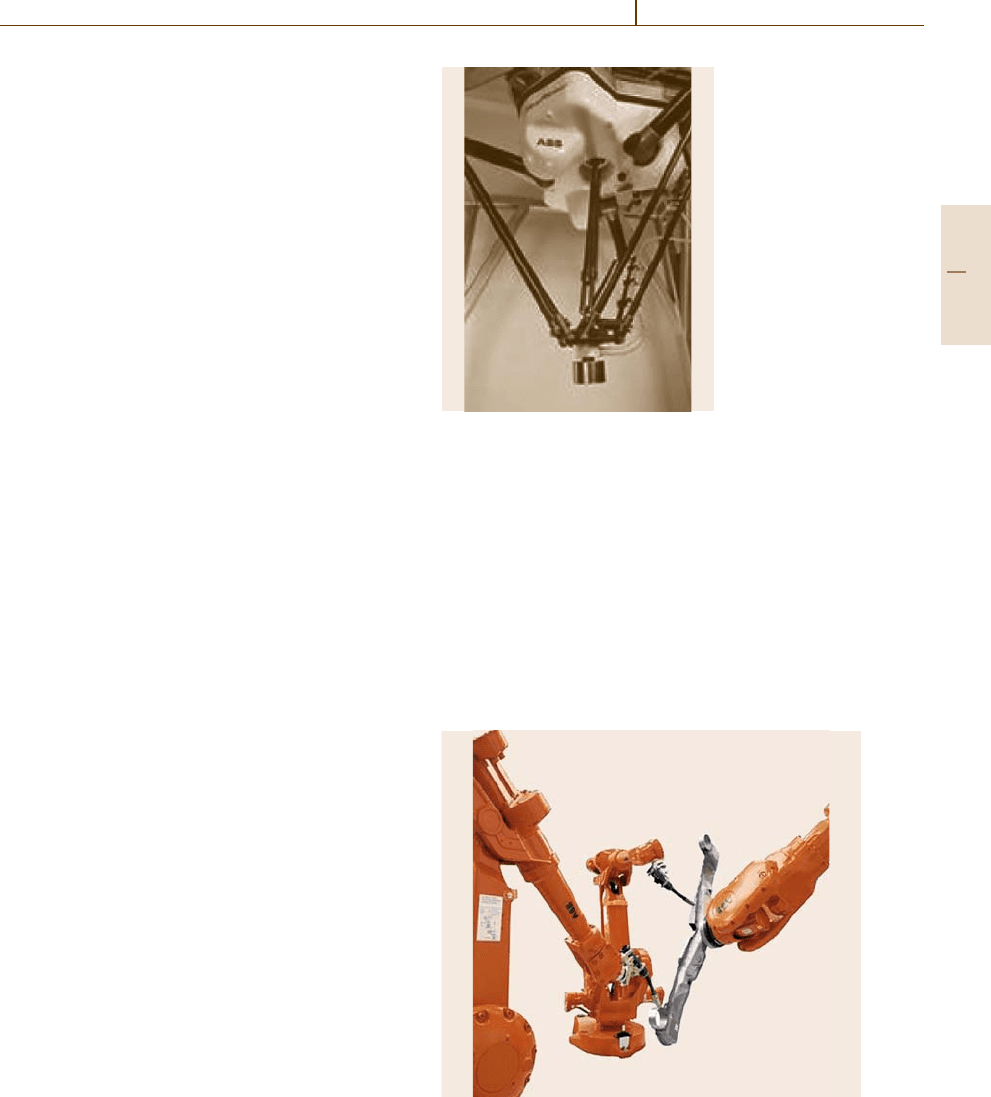
Product Automation 32.9 Elements for Product Automation 553
programmable logic controllers (PLC) is greatly re-
duced andautomation reliabilityimproves dramatically.
The modern driveis programmedvia a control panel
that is similar in look, feel, and functionality to a mobile
phone. A large graphical display and soft keys make it
extremely easy to navigate. This detachable, multilin-
gual alphanumeric control panel, as shown in Fig.32.8,
allows access to various assistants and a built-in help
function to guide the user during start-up, maintenance,
and diagnostics. For example, a real-time clock assists
in rapid fault diagnostics. When a fault is detected, a di-
agnostic assistant will suggest ways to fix the problem.
Drive setup and configuration data can be copied from
one motor controller to another to ensure that, in the
event of a drive failure, there isno need to start the setup
process from the beginning.
Today, mid-range drives can store five times the
amount of information compared with typical drives
from the 1980s. In addition, drives with increased pro-
cessing power and memory enable configurations that
are better suited to an application.
In industry today, software modifications are the
most usefuland cost-effectiveway ofmodifying adrive.
This is because developments in software have given
drives increased capability with less hardware; for ex-
ample, a drive controlling a conveyor belt in a biscuit
factory can be programmed to operate in many different
ways, such as starting and stopping at certain intervals
or advancing a certain distance. The same drive used
in a ventilation system can be programmed to maintain
constant air pressure in a ventilation duct.
Software developments are also leading to drives
with adaptive programming.Adaptive programmingen-
ables the user to freely program the drive with a set of
predefined software blocks with predefined functions.
32.9.5 Robots
Robots are the prototype of product automation as they
present the impression of a self-determined machine in
the most visible way.
The classical application of robots is found in car
manufacturing, where hundreds of devices perform
movements, grinding, welding, painting, assembly, and
other operations in the flow production (see Chap.21
and [32.19,20]).
Other applications of robotic support are less well
known but are entering the market on a broad base.
The FlexPicker from ABB (Fig.32.9) is one such
example: It is a parallel kinematics robot that offers
a great combination of speed and flexibility [32.21].
Fig. 32.9 The
FlexPicker robot
achieves accel-
erations of 10g
and handles up
to 120item/min
The gripper can pick items with picking rates exceed-
ing 120 items per minute. The products can be picked
and placed one by one. Since all the motors and gears
are fixed on the base of the robot, the mass of the mov-
ing arms is limited to a few kilograms. This means that
accelerations above 10 g can be achieved. Automation
of this fast movement puts different requirements on the
automation system of the device than, for example, the
slow welding of a car roof.
While the primary automation of the robot move-
ment is fully developed (the world’s first electrically
driven robot was introduced as early as 1974), the
Fig. 32.10 The MultiMove function, which is embedded
into the IRC5 software, allows up to four robots and their
work-positioners or other devices to work in full coordina-
tion
Part D 32.9
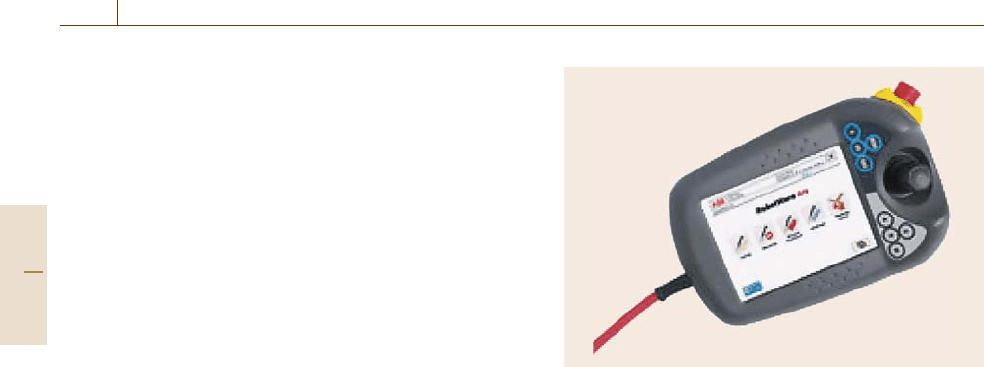
554 Part D Automation Design: Theory and Methods for Integration
further improvements come, such as in the drives ex-
amples, from better coordination of several robots,
a simplified man–machine interface, and easier pro-
gramming methods for the robot systems.
The recently launched robot controller IRC5 from
ABB, presenting the fifth generation of robot con-
trollers, introduces MultiMove (Fig.32.10). MultiMove
is a function embedded into the IRC5 software that al-
lows up to four robots and their work-positioners or
other devices to work in full coordination. This ad-
vanced functionality has been made possible by the
processing power and modularity of the IRC5 control
module, which is capable of calculating the paths of up
to 36 servo axes [32.22].
The FlexPendant (Fig.32.11) [32.22] is a handheld
robot–user interface for use with the IRC5 controller.
It is used for manually controlling or programming
a robot, or for making modifications or changing set-
tings during operation. The FlexPendant can jog a robot
through its program, or jog any of its axes to drive the
robot to a desired position, and save and recall learnt
positions and actions.
The ergonomically designed unit weighs less than
1.3kg. It has alargecolor touchscreen, eightkeys,a joy-
stick, and an emergency stop button. The user-friendly
interface is based on Microsoft’s CE.NET system. It
can display information in 12 languages of which 3
can be made active simultaneously, meaning languages
can be changed during operation. This is useful when
staff from different countries work in the same fac-
Fig. 32.11 Handheld programming
tory. The display can be flipped by 180
◦
to make the
FlexPendant suitable for left- or right-handed opera-
tors. The options can be customized to suit the robot
application.
Programming of robots to fulfill their sometimes
quite complicated task requires a lot of time and can
in most cases be done by specialists only. However,
considerable progress has been made by virtual robot
programming that allows offline programming with
models. Recently these systems can also be directly
connected to the robots, which is especially useful to set
up a new robot installation. Background software pro-
grams and the use of templates significantly facilitate
this programming work.
32.10 Embedded Systems
Most of the examples given in Sect.32.9 have the
automation function embedded in the product, mak-
ing embedded system a common feature for product
automation.
Embedded systems are special-purpose computer
systems that are totally integrated and enclosed by the
devices that they serve or control – hence the term
embedded systems. While this is a generally accepted
definition of embedded systems, it does not give many
clues as to the special characteristics the systems pos-
sess. The use of general-purpose computers, such as
PCs, would be far too costly for the majority of prod-
ucts that incorporate some form of embedded system
technology. A general-purpose solution might also fail
to meet a number of functional or performance require-
ments such as constraints in power consumption, size
limitations, reliability or real-time performance.
Most present product automation could not have
been conceived without embedded system technology.
Examples are distributed control systems (DCS)that
can safely automate and control large and complex in-
dustrial plants, such as oil refineries, power plants, and
paper mills. In the early days of industrial automation,
relay logic was used to perform simple control func-
tions. With the advent of integrated circuits and the first
commercial microcontrollers in the 1970s and 1980s,
programmable industrial controllers were introduced to
perform more complex control logic.
Industrial requirements vary enormously from ap-
plication to application, but special industrial require-
ments typically include:
•
Availability and reliability
•
Safety
Part D 32.10
